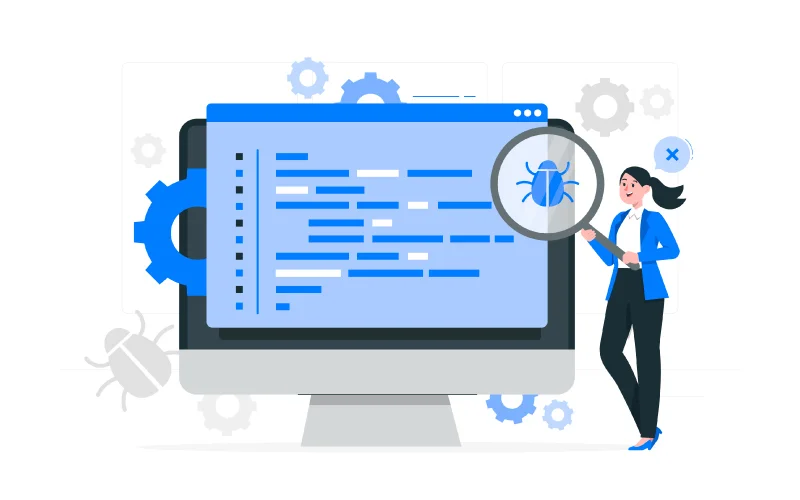In the software development life cycle, software testing stands as a pivotal phase, placing paramount importance on the end product’s quality, reliability, and functionality. The process entails a diverse array of methodologies and techniques to identify and rectify bugs and defects, ensuring a robust software. This guide delves deeply into software testing, encompassing its profound significance, fundamental practices, and optimal execution of QA strategies. Let’s embark on a thorough exploration of software testing, unraveling the essential practices that form the bedrock of successful software development.
Meaning of Software Testing
Software testing encompasses employing a range of testing techniques like unit testing, integration testing, system testing, acceptance testing, and regression testing. These approaches collectively ensure a comprehensive evaluation of the software, promoting reliability, security, and functionality. Additionally, implementing Continuous Integration and Continuous Deployment (CI/CD) practices amplifies testing efficiency by enabling automated testing at each development stage. This meticulous testing instils confidence in meeting user expectations and industry standards.
Leveraging its expertise in both manual and automated testing, Sanmark plays a crucial role in implementing these practices. Manual testing involves human intervention to validate software functionality, usability, and performance through real-world user scenarios. Sanmark’s skilled manual testers ensure a thorough evaluation covering various domains and industries. On the other hand, automated testing utilises specialised tools for faster test case execution, increasing test coverage and bug identification efficiency. Sanmark’s automated testing services deploy cutting-edge tools and frameworks tailored to project needs, significantly enhancing testing efficiency and ensuring a robust and timely software release.
Key Practices for Software Testing
- 1. Requirements Analysis and Test Planning
Successful software testing starts with a thorough analysis of project requirements, followed by the creation of a comprehensive test plan. This plan outlines testing objectives, strategies, resources, and schedules, ensuring a structured approach to testing.
- 2. Thorough Testing
To ensure the software’s robustness and reliability, thorough testing is vital. It involves testing various aspects, including functional, non-functional, and regression testing, to identify bugs and defects across different functionalities and features.
- 3. Automation Testing
Automating repetitive and time-consuming test cases can significantly enhance the efficiency and effectiveness of the testing process. Automation tools help execute a large number of test cases swiftly and accurately, improving overall testing productivity.
In the context of improving testing efficiency, automating repetitive and time-consuming test cases is crucial. Utilizing a powerful framework like Laravel can further enhance this process. Hire top Laravel developers who can assist you in implementing sophisticated automation solutions tailored to your needs.
- 4. Traceability Matrix
A traceability matrix is a valuable tool that helps map requirements to test cases, ensuring that every requirement is covered by corresponding tests. This matrix aids in tracking the progress of testing and ensures all aspects of the software are tested thoroughly.
- 5. Defect Tracking and Reporting
Efficiently tracking defects and reporting them is critical for a successful software testing process. This practice helps in documenting defects, analysing their impact on the software’s functionality, and aiding developers in addressing these issues effectively.
- 6. Risk-Based Testing
Identifying and assessing risks associated with the software is paramount. Prioritising testing efforts based on identified risks ensures that critical areas are thoroughly tested, mitigating potential risks and ensuring higher quality products.
- 7. Performance Testing
Performance testing evaluates the software’s responsiveness, stability, and scalability under various load conditions. This practice ensures the software can handle the expected load and perform optimally even during peak usage.
- 8. Security Testing
Security testing is crucial to verify the software’s ability to protect data and systems. It involves identifying vulnerabilities and weaknesses that could be exploited, ensuring a secure software environment.
- 9. User Acceptance Testing (UAT)
Involving end-users to validate the software ensures it meets their requirements and expectations before release. UAT is a critical step to gather feedback and make necessary improvements based on user insights.
- 10. Continuous Improvement
The software testing process should be viewed as a dynamic and evolving aspect of the development cycle. Continuous evaluation and improvement of testing processes, methodologies, and tools are necessary to adapt to changing requirements and technologies, ultimately enhancing efficiency and effectiveness.
 https://www.freepik.com/free-vector/software-tester-concept-illustration_40468676.htm#
https://www.freepik.com/free-vector/software-tester-concept-illustration_40468676.htm#
How to Implement QA Best Practices
Enforcing optimal Quality Assurance (QA) practices is vital in guaranteeing superior software quality and streamlined development procedures. Below is a detailed step-by-step manual to assist you in effectively incorporating these QA best practices:
- 1. Understand Project Requirements and Objectives
Gain a comprehensive understanding of the project’s goals, requirements, and client expectations.
- 2. Define QA Strategy and Processes
Create a clearly outlined QA approach customised to suit the project’s requirements, encompassing the choice of suitable testing categories, approaches, and tools. Set up QA procedures and sequences to guarantee uniformity and effectiveness in testing endeavors.
- 3. Integrate QA Early in the Development Lifecycle
Start QA activities early in the development process to detect and address issues at the initial stages, reducing costs and development time.
- 4. Establish Clear QA Standards and Guidelines
Define clear QA standards and guidelines that outline the expectations for coding, testing, documentation, and other development aspects.
- 5. Implement Test Automation
Automate repetitive and time-consuming testing tasks to increase efficiency, test coverage, and speed of execution.
- 6. Ensure Comprehensive Test Coverage
Develop test cases that cover all aspects of the application, including functional, non-functional, performance, security, and usability testing.
- 7. Collaborate and Communicate Effectively
Foster effective communication and collaboration between development, QA, and other stakeholders to ensure a shared understanding of project goals and expectations.
- 8. Regularly Review and Update QA Processes
Regularly review QA processes, seeking opportunities for improvement and making essential updates to boost efficiency, effectiveness, and overall quality of the software development lifecycle. Stay committed to continuous enhancement.
By implementing these guidelines and staying in line with QA best practices, you can elevate your software’s quality, streamline development processes, and deliver products that not only meet but surpass client expectations.
Outline
Incorporating the outlined QA practices is essential for successful software testing, resulting in a high-quality end product that meets and exceeds user expectations. These practices, ranging from meticulous requirements analysis to continuous improvement, are vital components of a comprehensive testing strategy. Implementing thorough testing, utilising automated tools, and continuously refining testing processes will result in a robust and reliable software system.
By diligently following these QA practices, you can build software that not only meets but exceeds expectations, delivering an exceptional user experience and establishing a strong reputation in the competitive software development landscape. For companies seeking expert guidance and implementation of QA best practices, Sanmark is a reliable choice. Sanmark, a company known for employing top-tier QA practices, is committed to assisting in enhancing the quality of software. Our experienced team ensures that your software meets the highest standards, leaving a lasting positive impression on your clients and users.
Stay informed about the latest advancements in software testing and QA methodologies by subscribing to Sanmark’s newsletter. Don’t miss out on valuable insights that can help enhance your software testing approach and contribute to the overall success of your projects. Let Sanmark be your trusted QA partner, ensuring a seamless journey to superior software quality.
Feature image sources: https://www.freepik.com/free-vector/business-people-working-laptop-development_4332351.htm#
